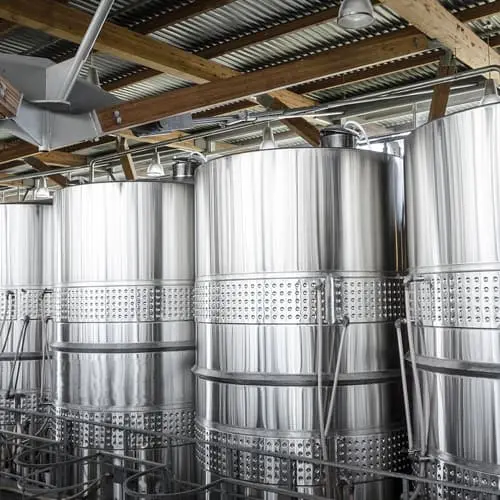304 stainless steel tubing is the most widely used stainless steel product around the globe, revered for its excellent combination of features that cater to both industrial and residential needs. This type of stainless steel belongs to the T-300 series of stainless steel alloys, which are characterized by their 18% chromium and 8% nickel composition. This specific alloy composition not only provides impressive resistance to corrosion and oxidation but also offers a high degree of formability and durability, making it an ideal choice for various applications.

Why Choose 304 Stainless Steel?
The choice of 304 stainless steel tubing is no coincidence. Its corrosion resistance is exemplary, allowing it to withstand exposure to a wide range of chemical agents and atmospheric conditions without succumbing to rust. This makes it perfectly suited for use in environments where both the strength of steel and resistance to corrosion are required.
Furthermore, 304 stainless steel's resistance to extreme temperatures makes it suitable for applications ranging from cryogenic to high-heat environments, adding to its versatility. Its ease of cleaning and low maintenance requirements contribute to its popularity in industries where hygiene is a priority, such as food and beverage processing, pharmaceuticals, and kitchens.
Understanding Tube Sizes and Measurements
When it comes to selecting the right 304 stainless steel tubing for any project, understanding the significance of tube sizes and measurements is crucial. These dimensions not only determine the compatibility and efficiency of the tubing in specific applications but also its strength, pressure handling, and overall performance.
Outer Diameter (OD): The OD is one of the most important measurements, as it often correlates with the fitting sizes and clearance requirements. It's the external measurement across the tubing, critical for ensuring the tubing fits within the designated spaces or matches up with connecting components.
Wall Thickness (WT): The wall thickness of a tube directly impacts its strength and pressure rating. Thicker walls mean higher pressure tolerance but also result in a smaller inner diameter (ID) for the same OD, affecting the flow rate. The balance between wall thickness and ID is essential for optimizing performance and material use.
Length: The length of the tubing is also a crucial factor to consider. It determines how much material is needed for a project and affects the installation process, including how the tubing will be transported, handled, and cut on site. The length can vary widely depending on the application, from short pieces required for compact machinery to long stretches needed for piping systems. Custom lengths are often available to meet specific project requirements, reducing waste and the need for additional connections or fittings.
Inner Diameter (ID): The ID is the interior open space of the tubing, through which fluids or gases pass. It's a vital measurement for applications where flow rate and pressure drop are critical factors. The ID, in conjunction with the wall thickness, determines the tube's ability to handle specific volumes and types of materials under various conditions.
Importance of Precision in Measurements
Precision in these measurements is paramount, as even slight deviations can lead to leaks, inadequate flow rates, or even system failures. For engineers and project managers, understanding the tolerances and how they affect the system's integrity is a key part of the selection process.
Standard Sizes and Custom Options
Navigating the selection of 304 stainless steel tubing involves understanding the standard sizes available in the market and when custom options might be necessary. Manufacturers typically offer a wide range of sizes to accommodate the diverse needs of different projects, ensuring that there is a fit for almost every application.
Chart of Commonly Available Sizes
Standard sizes of 304 stainless steel tubing are categorized by their outer diameter (OD) and wall thickness (WT), ranging from small diameter tubing for precise applications to larger tubes for heavy-duty use. These sizes are readily available:
Small Diameter Tubing: Typically ranges from 1/8 inch to 1 inch OD, with wall thicknesses starting as thin as 0.02 inches. Ideal for applications requiring precision, such as in medical or aerospace equipment.
Medium Diameter Tubing: Ranges from 1 inch to 4 inches OD. These sizes are often used in food processing equipment, chemical transport, and architectural applications.
Large Diameter Tubing: Larger than 4 inches OD, designed for industrial applications, structural supports, and large-scale fluid transport systems.
The choice of size depends on factors such as the required flow rate, pressure capacity, and the physical space constraints of the project.
Considerations:
Size Selection: Consider the specific requirements of the application, including the nature of the fluid, pressure, temperature, and flow rate.
Corrosion Resistance: While 304 stainless steel offers good corrosion resistance, more aggressive environments (such as high salinity or acidic conditions) may necessitate a higher grade material like 316 stainless steel.
Processing and Installation: Different sizes and wall thicknesses may require specific tools and techniques for processing and installation.
Cost-Effectiveness: When choosing sizes and wall thicknesses, consider the budget and cost-effectiveness of the project, especially for large-scale applications.
Custom Sizing Options
While standard sizes meet most needs, there are instances where custom-sized 304 stainless steel tubing becomes necessary. Custom sizes can be manufactured to specific ODs, WTs, and lengths, offering solutions for unique projects or applications that demand precise specifications not covered by standard sizes.
Custom tubing is particularly valuable in situations where:
Unique Applications: Projects with unique design challenges or specific engineering requirements.
Optimized Performance: Tailored sizes can enhance performance by optimizing flow rates and pressure handling.
Space Constraints: When the installation space demands tubing dimensions that are not standard.
Requesting custom sizes involves consulting with manufacturers to discuss the project's requirements, including dimensions, tolerances, and any additional processing or finishing services needed. This collaboration ensures that the custom tubing meets the project's exact specifications, ensuring success.
Choosing the Right Size for Your Project
Selecting the correct size of 304 stainless steel tubing is pivotal in ensuring the success and efficiency of any project. The size and specifications of the tubing should match the project's requirements closely, taking into account factors such as flow rate, pressure, and the physical environment in which the tubing will be used. Here are key considerations to guide you in making an informed decision:
1. Flow Requirements:
High Flow Rates For projects requiring high flow rates, larger inner diameters (ID) will minimize resistance and facilitate the desired volume of material passing through the tubing.
Precise Control: Smaller tubing sizes might be preferable for applications needing precise flow control or where the fluid being transported is valuable and needs to be used sparingly.
2. Pressure Ratings:
High-Pressure Applications Thicker walls (greater wall thickness) are essential for tubing used in high-pressure applications, as they provide the necessary strength to withstand internal pressures without failing.
Balancing Pressure and Flow: It's crucial to balance the need for pressure capacity with the desired flow rate, as increasing wall thickness to handle more pressure may reduce the inner diameter and, consequently, the flow rate.
3. Compatibility and Integration:
Fitting and Connectors The outer diameter (OD) must be compatible with existing systems, fittings, and connectors to ensure a seamless and leak-free integration.
Space Constraints: Consider the available space for the tubing, especially in tight or confined areas, where the OD and flexibility of the tubing become critical factors.
4. Project-Specific Requirements:
Temperature and Chemical Exposure Depending on the environment and materials the tubing will be exposed to, certain sizes may be more suitable to ensure durability and maintain integrity under specific conditions.
Regulatory and Safety Standards: Always consider relevant industry standards and safety regulations that may dictate specific size or material requirements for your tubing.
5. Expert Consultation:
Engaging with manufacturers or specialists can provide valuable insights into selecting the ideal tubing size for your project. Their expertise can help navigate the complexities of matching tubing specifications with project needs.
The process of choosing the right size of 304 stainless steel tubing is a nuanced decision that impacts the functionality, safety, and cost-efficiency of a project. By carefully considering these factors, you can ensure that your selection not only meets the immediate needs of your project but also contributes to its long-term success and sustainability.


